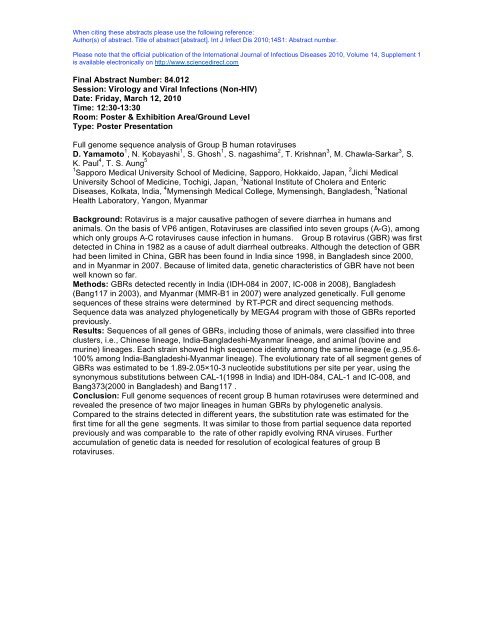14th ICID - Poster Abstracts - International Society for Infectious ...
14th ICID - Poster Abstracts - International Society for Infectious ...
14th ICID - Poster Abstracts - International Society for Infectious ...
Create successful ePaper yourself
Turn your PDF publications into a flip-book with our unique Google optimized e-Paper software.
When citing these abstracts please use the following reference:<br />
Author(s) of abstract. Title of abstract [abstract]. Int J Infect Dis 2010;14S1: Abstract number.<br />
Please note that the official publication of the <strong>International</strong> Journal of <strong>Infectious</strong> Diseases 2010, Volume 14, Supplement 1<br />
is available electronically on http://www.sciencedirect.com<br />
Final Abstract Number: 84.012<br />
Session: Virology and Viral Infections (Non-HIV)<br />
Date: Friday, March 12, 2010<br />
Time: 12:30-13:30<br />
Room: <strong>Poster</strong> & Exhibition Area/Ground Level<br />
Type: <strong>Poster</strong> Presentation<br />
Full genome sequence analysis of Group B human rotaviruses<br />
D. Yamamoto 1 , N. Kobayashi 1 , S. Ghosh 1 , S. nagashima 2 , T. Krishnan 3 , M. Chawla-Sarkar 3 , S.<br />
K. Paul 4 , T. S. Aung 5<br />
1 Sapporo Medical University School of Medicine, Sapporo, Hokkaido, Japan, 2 Jichi Medical<br />
University School of Medicine, Tochigi, Japan, 3 National Institute of Cholera and Enteric<br />
Diseases, Kolkata, India, 4 Mymensingh Medical College, Mymensingh, Bangladesh, 5 National<br />
Health Laboratory, Yangon, Myanmar<br />
Background: Rotavirus is a major causative pathogen of severe diarrhea in humans and<br />
animals. On the basis of VP6 antigen, Rotaviruses are classified into seven groups (A-G), among<br />
which only groups A-C rotaviruses cause infection in humans. Group B rotavirus (GBR) was first<br />
detected in China in 1982 as a cause of adult diarrheal outbreaks. Although the detection of GBR<br />
had been limited in China, GBR has been found in India since 1998, in Bangladesh since 2000,<br />
and in Myanmar in 2007. Because of limited data, genetic characteristics of GBR have not been<br />
well known so far.<br />
Methods: GBRs detected recently in India (IDH-084 in 2007, IC-008 in 2008), Bangladesh<br />
(Bang117 in 2003), and Myanmar (MMR-B1 in 2007) were analyzed genetically. Full genome<br />
sequences of these strains were determined by RT-PCR and direct sequencing methods.<br />
Sequence data was analyzed phylogenetically by MEGA4 program with those of GBRs reported<br />
previously.<br />
Results: Sequences of all genes of GBRs, including those of animals, were classified into three<br />
clusters, i.e., Chinese lineage, India-Bangladeshi-Myanmar lineage, and animal (bovine and<br />
murine) lineages. Each strain showed high sequence identity among the same lineage (e.g.,95.6-<br />
100% among India-Bangladeshi-Myanmar lineage). The evolutionary rate of all segment genes of<br />
GBRs was estimated to be 1.89-2.0510-3 nucleotide substitutions per site per year, using the<br />
synonymous substitutions between CAL-1(1998 in India) and IDH-084, CAL-1 and IC-008, and<br />
Bang373(2000 in Bangladesh) and Bang117 .<br />
Conclusion: Full genome sequences of recent group B human rotaviruses were determined and<br />
revealed the presence of two major lineages in human GBRs by phylogenetic analysis.<br />
Compared to the strains detected in different years, the substitution rate was estimated <strong>for</strong> the<br />
first time <strong>for</strong> all the gene segments. It was similar to those from partial sequence data reported<br />
previously and was comparable to the rate of other rapidly evolving RNA viruses. Further<br />
accumulation of genetic data is needed <strong>for</strong> resolution of ecological features of group B<br />
rotaviruses.
















